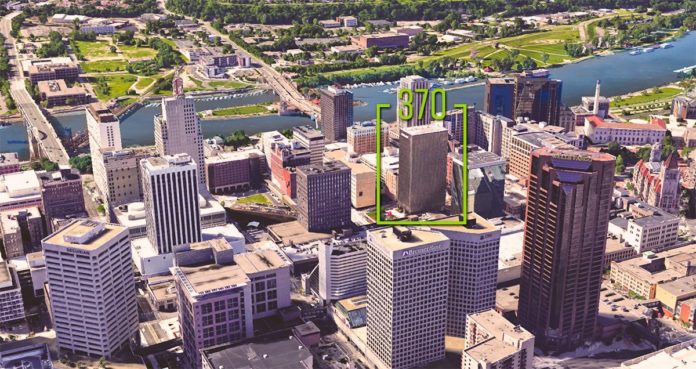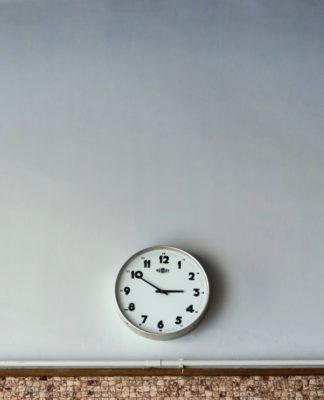
Exposed brick lines the walls. Pipes hang high over desks covered in med-tech prototypes, white boards, and dozens of computer monitors and laptops. Coders and software engineers sit hunched in front of their screens, clicking away with eyes squinted almost closed, hard at work but still comfortable, at home in their surroundings.
It’s clearly not your typical corporate office: The room is bright, open, dominated by big windows and the posters of favorite bands and movies, pictures of employee travels around the world, cases of beer and Red Bull. It’s exactly what you’d think when you think of a coworking space, based in a booming U.S. metro area. But we’re not on the West Coast or in New York City. No, we’re standing in the heart of St. Paul, Minnesota.
At present and future
The space, specifically, is Primordial Soup (P-Soup), a “strategic design and engineering consulting firm” that invents medical devices and more, located in the historic Allen Building (built in 1907) in the fast-growing Lowertown neighborhood adjoining the city’s downtown.
Twin Cities Startup Week (#TCSW) ended last Friday 10/13, culminating at St. Paul’s new Palace Theater for the final awards ceremony.
Which is cool in and of itself.
As part of Startup Week, Full Stack Saint Paul (a public/private partnership aimed at supporting tech startups in the capital city) hosted a “startup crawl” to give networking enthusiasts, innovators, wantrepreneurs, and anyone else interested a chance to look at what’s going on in the city. Along with P-Soup, the crawl visited Creed Interactive, a web design company located in Market House (next to a new food hall recently opened under James Beard-award winning chef Tim McKee), and the James J. Hill Center where classes and programs are offered weekly to help struggling and thriving startups alike.
(Full listing of J.J. Hill Center events found here: www.jjhill.org/public-programs)
And, perhaps most exciting, the crawl offered a look Osborn370, the former Ecolab tower being converted into the city’s premier tech hub and coworking space; something of a beacon for Full Stack’s plan for tech/business/startup dominance.
Read more about Osborn370 here: Optimism in downtown St. Paul as Osborn370 lands tenants.
This could, to the more cynical among us, seem like just another capital city ploy to catch up with the job growth/sustainability found in Minneapolis, or even Bloomington. But there are more than a few reasons that Full Stack’s vision could/should/will come to fruition, and that it won’t just be a one-off.
Go (Mid)west, young man
Events like the Startup Crawl, and the Twin Cities Startup Week in general, are only the beginning.
There must be a base, first, committed to providing jobs and fostering local startups. Like Scott Burns, who stayed committed to St. Paul after striking gold with GovDelivery and is now basing his new company, Structural, in Osborn 370. This is the beauty of it: Companies that remain in the city after finding success and “pay it forward” by contributing to the city’s continued growth.
Or, at the very least, help to bring new jobs and younger talent to the city center.
But this is where Osborn370 (et al) really comes into play: There can’t be much of a base if there is nowhere to put it. The open space of formerly unused or abandoned, or simply outmoded, buildings in St. Paul offer prime opportunity for startups to move in cheap(er); of which Osborn is the largest.
This is important: Cities like St. Paul aren’t going to have the high costs for startup space of cities like San Francisco. Or even Minneapolis for that matter. Many startups have begun moving away from high-cost cities to smaller cities like Portland, OR, Columbus, OH, and (drum roll) St. Paul, MN.
And St. Paul also has the talent: With a myriad of respected higher education institutions around the city, St. Paul is, in a lot of ways, one really big college town. Schools like St. Thomas offer programs focused on tech, science, and engineering, and the U of M’s St. Paul campus continues to feed Minnesota’s status as “the Silicon Valley of food.”
The base that is here, ready to enter the workforce, is also an educated one. And no longer will our students have to head west to find well-paying, fulfilling work, or the opportunity to launch their own business/company/startup.
The blueprint
St. Paul has also finally begun to understand how to use its unique lay out to its advantage. The old warehouses of Lowertown (housing Creed Interactive and Primordial Soup, as mentioned), have also given rise to a unique culture mix of housing, dining, and entertainment for an interactive landscape also congruent to creative growth and prosperity.
The narrow streets are infinitely walkable, and there are a growing number of things to actually walk to. Light Rail chugs through formerly silent streets. The Union Depot offers bike service at the end of a rather impressive separated bike lane*, along train, bus, and car transport as a truly multi-modal transit hub. The downtown area is fast beginning to look like the sort of downtown that fosters growth and innovation; the sort of city center that attracts, and maintains a vibrant, loyal population.
*The bike lane is part of a greater Bicycle Plan that goes, in, out, and around downtown, and the rest of the city.
This isn’t to say there aren’t still problems still facing the city’s CBD, and that there won’t continue to be (we discuss this in depth here: St. Paul still searching for downtown business boom), but the potential for St. Paul to restart as a thriving business center, centered specifically around tech, innovation, and long-term jobs that cater to a younger, hungrier workforce, is there.
It’s about today, tomorrow, and long beyond. We can never truly know the future, of course. But the strides made today are to ensure that it’s going to be a bright(er) one.
















